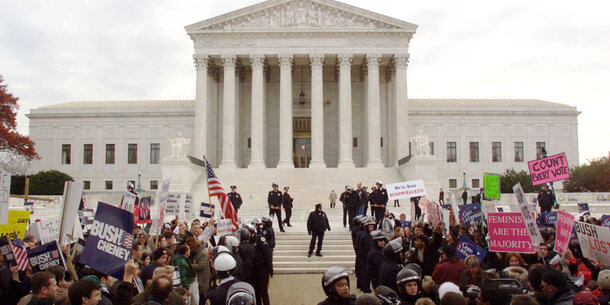U.S. politics in the 21st century is defined by division: polarization, culture wars, a fast-moving and ideologically driven news ecosystem, and social media platforms that proliferate extremism and misinformation. As Americans struggle to achieve social cohesion and tackle the problems the country faces, a narrative of a civic crisis has arisen. In the face of threats to our systems of democracy, there has been a call for a bottom-up solution: revitalized civic education and engagement. The argument is that an educated, engaged, and active citizenry can begin to heal the divisions riddling our society.
Frustrations about our political system have sometimes appeared as an antagonistic relationship between generations. Older generations latch on to narratives of Millennials and Generation Z as spoiled, lazy, and oversensitive, judging today’s youth on the basis of a “Back in my day . . .” nostalgia and discounting the unique challenges that young people face in 21st-century America. 1 For their part, these younger generations sum up their resentment of preceding ones in the dismissive quip “OK, Boomer,” using humor to critique the traditional — and, to them, antiquated — worldviews associated with Baby Boomers and, to some extent, Generation X.
Neither side of this generational divide is the monolith the other paints it to be, yet these caricatures are perpetuated throughout popular culture and media. Rather than working to create a mutually beneficial civil society and change a political system that fails to meet the needs of youth and adults alike, Americans have turned their frustrations against one another. Distracted by generational conflict, we miss the opportunity to leverage intergenerational interactions for civic repair.
These tensions contribute to the present civic crisis often being discussed through a generational lens, with each side pointing at the other to assign blame and responsibility for providing remedies. Young people are simultaneously accused of being disengaged and too disruptive in their engagement, while older people’s often traditional means of civic engagement and conventional worldviews are perceived to result in stasis. Many scholars and professionals advocate renewed focus on and increased investment in K–12 civic education as a solution, schools being the most obvious place to develop a more engaged citizenry. Supporting formal civic education especially in the face of legislation restricting teaching about American government and history — is critical in developing young people’s civic behavior. However, such a solution to the civic crisis leaves out large swaths of the population, namely adults whose civic skills have atrophied or need renewal.
Perhaps, in fact, our stunted view of civic learning relegating most civic development to formal education — is contributing to this national crisis. There is a myth in the United States that by the time you can vote, you are a fully developed civic agent, having received all the training necessary to participate in our democracy. Yet it is fanciful to imagine that 20th-century high school social studies classes have fully equipped adults with the civic knowledge and skills they need to tackle modern America, where economic, technological, social, and demographic changes have radically rewritten how national politics functions. The reality is that civic learning must be a lifelong endeavor if our systems of democracy are to be revitalized. In other words, to avert a deepening of our civic crisis, adults need civic learning, too.
Civic learning extends beyond mastering concrete facts about government; it also requires the acquisition and development of civic skills and dispositions. Civic skills include both actions by which we participate in our democratic society — such as voting, contacting government officials, evaluating news sources, and researching issues — and more subtle skills like argumentation, deliberation, collaborative decision-making, and connecting across differences. Civic dispositions are the values and mindsets that foster civic participation, including a commitment to the common good, an understanding of the power of one’s own voice in a democratic system, and a willingness to work with others toward shared goals. Each of these factors needs routine maintenance after we exit formal education. As our position in society, self-conception, and access to resources change, so must our civic development. Likewise, as the political environment around us changes, as it does every day, we always have more to learn. Already, much of the formal and informal civic learning happening in America is intergenerational in nature. Leaning into this is a potentially powerful way to facilitate lifelong civic learning that is rooted in personal experience and responsive to community change.
Intergenerationality describes contact between generations. Sometimes the word is narrowly defined to mean interaction between two generations, often separated by one generation (e.g., a grandparent and grandchild). Those using this definition sometimes place it in contrast to multigenerational interactions, which take place among more than two generations (e.g., a child, parent, and grandparent). Defining intergenerationality as existing among people of all generations, no matter their distance, allows an expanded view of the concept that is critical for building a civic culture for all ages.
Civic intergenerationality is an approach to civic learning grounded in coming together across the life span to create a social and political reality that supports people of all ages. It operates under the assumption that all people are assets to our community, are capable of civic learning, and would benefit from it. By embracing the practice of civic intergenerationality, we can address America’s ongoing civic crisis. We can create a community of lifelong, reciprocal learners that uplifts our youngest civic agents while leveraging the experiences and wisdom of older generations.
Not only can generations — young and old alike — use their unique expertise to share civic knowledge and skills with one another, but the very act of intergenerational communication requires participants to exercise civic skills and dispositions. Working together across generational lines helps individuals develop mutual respect, communication skills, collaboration, and power sharing. It also has been shown to increase generativity — a feeling of responsibility toward the well-being of future generations — and a sense of community while decreasing generational stereotypes that drive societies apart.2 Through intergenerational contact, communities can increase the social capital associated with collective civic action while facilitating valuable civic learning.3 Civic intergenerationality offers exciting pathways for civic learning across ages, turning it into a lifelong process rather than something isolated in K–12 education or during election seasons.
To begin to map the promise of civic intergenerationality, this paper first looks at the differences in how generations approach social and political life, including the issues they care about and civic tactics they engage in. The next section outlines three theoretical frameworks for conceptualizing the learning that takes place through civic intergenerationality: direction of learning, type of relationship, and learning outcome. Within each, certain models offer particularly effective forms of civic intergenerationality. Using these frameworks, the third section examines intergenerational learning on the issue of climate change, and the fourth section examines the particular ways this mode of learning takes place in immigrant households. The report concludes by examining how intergenerational contact is already being used in the civic space and how families, organizations, and communities can harness its power.
Notas al Pie
-
1
Stef W. Kight, “Poll: People View Millennials as ‘Spoiled’ and ‘Lazy,’ ” Axios, March 10, 2018, https://www.axios.com/millennials-atale-of-two-generations-ff2a6de5-cfde-42c5-ab38-ec0908fbfcc9.html. -
2
Erik H. Erikson, Childhood and Society (New York: W. W. Norton & Co., 1950); Tara L. Gruenewald et al., “The Baltimore Experience Corps Trial: Enhancing Generativity via Intergenerational Activity Engagement in Later Life,” The Journals of Gerontology: Series B 71, no. 4 (July 2016): 661–70, https://doi.org/10.1093/geronb/gbv005; and Jessica K. Taft and Hava Rachel Gordon, “Intergenerational Relationships in Youth Activist Networks,” in Families, Intergenerationality, and Peer Group Relations, ed. Samantha Punch, Robert Vanderbeck, and Tracey Skelton (Singapore: Springer, 2016), 1–21, https://doi.org/10.1007/978–981–4585–92–7. -
3
Sandra Kerka, “Intergenerational Learning and Social Capital,” ERIC Digest, no. 244 (2003), https://eric.ed.gov/?q=ED478947.



